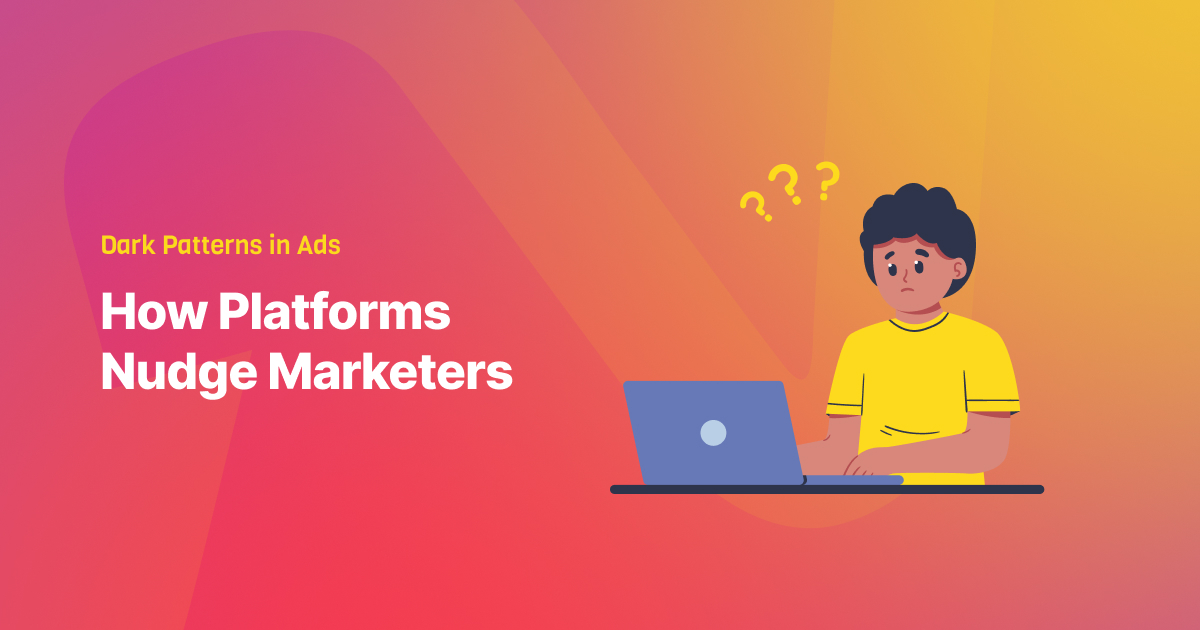Dark Patterns in Ads: How Platforms Nudge Marketers
You think you’re running ads on your terms.
But what if the platform itself is quietly pushing you toward decisions that don’t serve your best interest, but theirs?
That’s the hidden world of dark patterns in advertising.
In the past year alone, I’ve audited over 50 ad accounts across Google, Meta, and TikTok. More than half showed the same trend: marketers weren’t overspending because of a bad strategy. They were overspending because the platform designed the interface to nudge them into it.
Why It Matters
Dark patterns aren’t new. They’ve existed in UX for years interfaces designed to manipulate users into actions they didn’t fully intend, like endless free trial signups or “accidentally” sharing more data.
But here’s the twist: ad platforms now use similar tactics against the very marketers funding them.
Think about it:
- Google Ads’ “default recommendations” often push you to expand broad match keywords.
- Facebook Ads automatically optimizes to “Advantage+” placements—even when manual testing proves otherwise.
- TikTok prompts you with one-click “Boost” campaigns, making it sound like growth magic (but often it’s just wasted spend).
This matters because:
- Businesses are wasting ad budgets.
- Marketers are losing control of campaigns.
- Platforms are quietly increasing revenue under the guise of “optimization.”
And regulators are starting to notice. In 2023, the FTC flagged several cases of “deceptive design in advertising platforms” as part of their dark patterns crackdown.
Breaking Down the Concept: Dark Patterns in Ads
Let us simplify:
Dark patterns in ads occur when platforms develop campaign tools that prioritize their income aims over your marketing objectives.
Consider it as the difference between:
- Before: You are the pilot. You determine the flight path, account for turbulence, and land on target.
- After: The cockpit autopilot overrides you mid-flight and insists on a “faster” route, which actually consumes more fuel.
Here are some common examples:
- Default Spend Nudges recommend larger daily budgets and issue alerts such as “Limited performance detected” if not followed.
- Hidden Options: Important controls (such as precise match keywords or manual placements) are hidden behind layers of menus.
- One-Click “Easy Mode” Campaigns simplifies setup but removes control.
- Ambiguous metrics include “estimated audience reach” instead of conversions or profitability.
Why This Is Important Right Now
We’re entering a new phase of advertising where platform incentives are diverging from marketer incentives.
Google’s new Performance Max is the best example. Yes, it’s powerful. But it’s also a black box:
- You can’t see where half your budget is going.
- You’re nudged to increase spend for “maximum performance” with no transparency.
According to Adalytics 2024, nearly 32% of spend in certain Performance Max campaigns went to low-quality placements with questionable value.
Meta isn’t far behind. Their push for Advantage+ campaigns sounds like a dream (“let the AI optimize for you”), but case studies from Tinuiti show that Advantage+ works best only for certain accounts, while others experienced higher CPMs with little incremental lift.
Here’s why urgency matters:
- AI is accelerating this trend. Platforms argue: “Trust the algorithm.” But they’re not neutral. They profit when you spend more, not when you profit more.
- Budgets are tightening. Every wasted $500 is a lost opportunity for testing, scaling, or reinvesting.
- Regulators are circling. The EU’s Digital Services Act already requires more transparency in ad systems. U.S. may follow.
If you ignore this, you’re not just leaving money on the table; you’re handing over the steering wheel entirely.
Step-by-Step / Actionable Insights
So, how do you fight back against dark patterns without throwing away the power of automation?
Here’s a framework I use with clients:
Step 1: Identify the Nudge
- Check every “Recommended” or “Default” option.
- Ask: “Is this improving performance for me or for them?”
Step 2: Run Split-Tests Against Defaults
- If Google recommends broad match, run a split-test against exact/phrase match.
- If Meta pushes Advantage+, keep a parallel ad set with manual placements.
- Data will often prove the default isn’t the best choice.
Step 3: Set Guardrails
- Use spend caps and bid caps to prevent runaway budgets.
- In Performance Max, segment campaigns tightly by product/service to reduce “black box bleed.”
Step 4: Audit Regularly
- At least bi-weekly, check actual placements, spend distribution, and ROAS.
- Don’t trust topline “optimizations” to dig into where your money really goes.
Step 5: Document Everything
- Keep a log of tests, results, and anomalies.
- If regulators or stakeholders question why budgets shifted, you’ll have evidence.
Case Studies
Case Study 1: E-commerce Brand on Google Ads
- Problem: Google nudged them into Performance Max with “optimization score warnings.”
- Result: 40% of the budget went to Display placements with <0.3% conversion.
- Fix: We rolled back to Search-only campaigns, layered exact match, and scaled Shopping separately. ROAS improved 65% in 6 weeks.
Case Study 2: SaaS Company on Meta Ads
- Problem: Meta’s Advantage+ recommended full automation, removing manual interest targeting.
- Result: Costs per qualified lead jumped from $55 → $87.
- Fix: Rebuilt manual campaigns, retested lookalikes. Leads normalized at $58, saving ~$20K per quarter.
These aren’t isolated cases. They show a consistent pattern: when you hand total control to the platform, you often end up paying more for less.
Future Outlook
Here’s where things are heading:
- AI-First Ad Campaigns: Within 2 years, most platforms will default advertisers into AI-driven “black box” campaigns. Manual controls will be hidden or removed.
- Regulation as a Counterforce: The EU already fines companies for manipulative defaults. Expect similar moves globally by 2026.
- Rise of Independent Auditing Tools: Third-party analytics (like Adalytics, Northbeam) will gain traction as marketers demand transparency.
- Marketers as Watchdogs: Success will depend less on pushing buttons in ad managers and more on interpreting data, resisting nudges, and holding platforms accountable.
The winners? Those who blend automation with human oversight.
Conclusion
Dark patterns in ads aren’t just a UX issue anymore; they’re a profitability issue.
The platforms don’t care about your ROAS. They care about your spending. And unless you actively push back, test, and audit, you’ll keep getting nudged into decisions that pad their bottom line, not yours.
But here’s the good news: marketers who recognize this trend now will dominate in the next wave. Because while everyone else blindly trusts “optimization,” you’ll be the one driving with clear data, real strategy, and controlled budgets.
So here’s your move:
- Audit your ad account this week. Look for one “recommended” setting that might be costing you.
- Run a split-test.
- Document the results.
Want help uncovering these hidden patterns?
We offer a Free Ad Account Dark Pattern Audit where I’ll walk through your campaigns, flag wasted spend, and give you a roadmap for regaining control.
Click here to request your audit
Because in 2026 and beyond, the marketers who win won’t be the ones who spend the most.
They’ll be the ones who see through the nudge.

